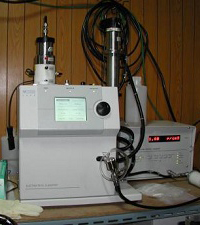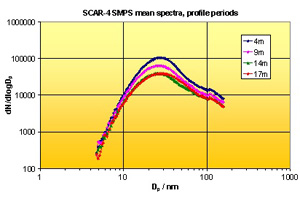Scanning Mobility Particle Sizer (SMPS)

Principle of Operation
The Scanning Mobility Particle Sizer is based on the principal of the mobility of a charged particle in an electric field. Particles entering the system are neutralized (using a radioactive source) such that they have a Fuchs equilibrium charge distribution. They then enter a Differential Mobility Analyser (DMA) where the aerosol is classified according to electrical mobility, with only particles of a narrow range of mobility exiting through the output slit. This monodisperse distribution then goes to a Condensation Particle Counter which determines the particle concentration at that size. The DMA consists of a cylinder, with a negatively charged rod at the center, the main flow through the DMA is particle free 'sheath' air. It is important that this flow is laminar. The particle flow is injected at the outside edge of the DMA, particles with a positive charge move accross the sheath flow towards the central rod, at a rate determined by their electrical mobility. Particles of a given mobility exit through the sample slit at the top of the DMA, while all other particles exit with the exhaust flow. The size of particle exiting through the slit being determined by the particles size, charge, central rod voltage, and flow within the DMA. By (in the case of the SMPS) exponentially scanning the voltage on the central rod, a full particle size distribution is built up. A more detailed description of the SMPS along with schematics can be found in the TSI Brochure.
Applications within the Centre for Atmospheric Science
The SMPS has been widely used since it’s purchase, and has proved to be extremely versatile in it’s uses. While we have had the capability to measure aerosol size distribution over the same size range as the SMPS for a number of years using DMPS systems (another variation based on the differential mobility analyzer technique), the SMPS does have some advantages over the existing systems. A major advantage is it’s ease of portability and significantly lower power consumption. It also can produce aerosol spectra with a much higher temporal resolution than the DMPS, though the sampling statistics suffer especially if fast scans are carried out under clean ambient conditions. The SMPS has proved to be ideal for a number of studies, and has been deployed in situations where it would have been almost impossible to deploy a DMPS. For example on top of the scissor lift platform used during the SCAR-4 experiment, or when characterizing a 20m aerosol inlet stack during the NAMBLEX project. It has also been used to produce monodisperse aerosol distributions for calibrating and testing other instruments.
Some Sample Results

SCAR-4 was a project looking at aerosol transport, and mixing etc within an urban street canyon. During this project the SMPS was located on the top of a movable platform, and measured at several different heights in the street canyon, ranging from about 4 – 17m. The plot below shows mean aerosol spectra a four different heights in the canyon. As would be expected, aerosol concentrations were greatest at lower heights, and decreased until roof level is reached (17m), there the distribution broadened slightly, and the peak diameter was larger by a few nm. This was probably due to mixing with air advected over the rooftops. A mean 24 hour time series showed that at busy times of day the surface aerosol concentration increased to a much greater extent than that at rooftop level. This has significant implications when assessing the implications of urban pollution on human health, as it shows that exposure is very dependant on location within the canyon.
General Information and Technical Specification

Our SMPS is a TSI Inc Model 3936NL25 SMPS, ie. consists of the Model 3080 classifier, a 3025A-S condensation particle counter, and has both the 3081 and 3085 DMA's, which are interchangeable. We also have several other CPC's which can be used with the SMPS, including a 3010 when only the Long DMA is to be used, and a 3085 water based CPC for applications where it is not practical or desirable to use butanol.
This system has the following general specifications:
Total Size Range 3-1000nm
Optimum Size Range 3-800nm
However, at any one time with a specific DMA the size ranges are:
Long DMA - Total Size Range 10-1000nm
Long DMA - Optimum Size Range 20-800nm
Nano DMA - Total Size Range 3-150nm
Nano DMA - Optimum Size Range 3-150nm
Particle Concentration Range 20-10,000,000 particles/cc
Minium Scan Time 60 seconds
Resolution 162 Size Channels, with up to 64 channels per decade of aerosol diameter.
SMPS Project Involvement
Publications using SMPS data
The SMPS is supported by the NCAS Facility for Ground-based Atmospheric Measurement (FGAM).